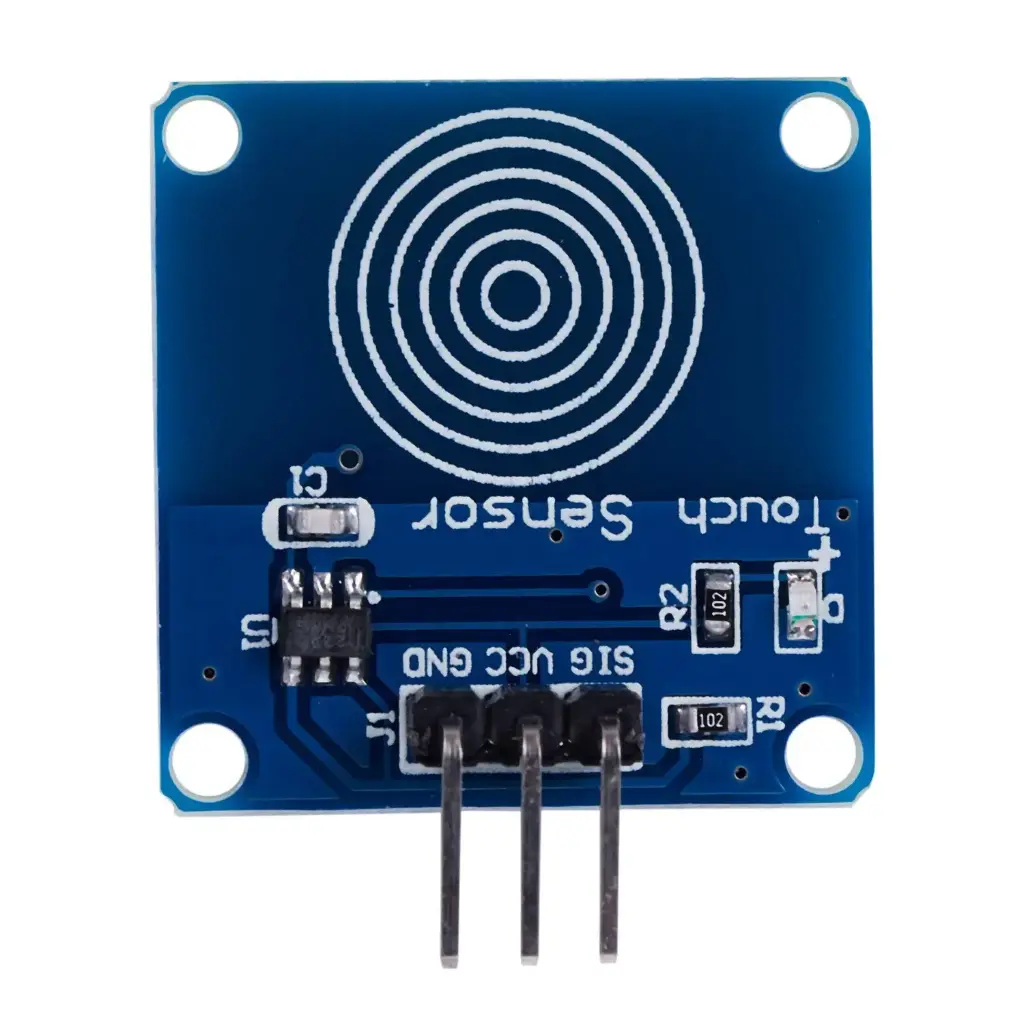Features:
- Low power consumption: Energy-efficient operation
- Replaces traditional keys: Serves as a convenient touch-sensing alternative
- Four M2 screw holes: Easy to install and operate
- Wide compatibility: Can be installed on plastic, glass, and non-metallic materials
- Hidden installation: Suitable for use in walls, desktops, and more
- Quick response: Fast detection and output switching
- Automatic power-saving mode: Enters low-power mode after 12 seconds of inactivity

Specifications:
- Operating voltage: DC 2.0V ~ 5.5V
- VOH: VCC - 0.8V
- VOL: VCC - 0.3V
- Sink current: 8mA @ VCC = 3V
- Source current: -4mA @ VCC = 3V, VOL = 0.6V, VOH = 2.4V
- Response time: 220ms (low power mode), 60ms (quick mode)
- Dimension: 24 x 24 x 7.2mm
Applications:
- Home automation: Control lights, fans, and appliances
- Industrial controls: Use in machines and conveyor belts
- Automotive controls: Use in power windows, sunroofs, etc.
- Interactive exhibits: Ideal for museums and installations
- Security systems: For alarms and access control
- Medical equipment: Touch interface for diagnostics or monitoring systems
Pin Connections:
| Pin |
Description |
| VCC |
Power Supply: Connects to +3.3V or +5V |
| GND |
Ground: Connects to the negative terminal |
| SIG |
Signal Output: HIGH when touched, LOW when not |

Sample Project:
Circuit:
- Arduino Uno
- Capacitive Touch Sensor
- LED
- 680 Ohm Resistor
- Jumper Wires
- Mini Breadboard
Below is a wiring diagram. An LED with a resistor (1kΩ or less) is connected to light up when the sensor is touched.

Library:
No external library is required for this module to function.
Code:
int led = 7;
void setup() {
pinMode(led, OUTPUT);
Serial.begin(9600);
}
void loop() {
int cap_reading = analogRead(A0);
float volt_reading = (5.0 / 1023.0) * cap_reading;
Serial.print(volt_reading);
Serial.println(" Volts");
if (volt_reading > 1.5) {
digitalWrite(led, HIGH);
} else {
digitalWrite(led, LOW);
}
delay(20);
}
Notes:
- This module should not be covered with thin sheets of metal or conductive materials, as it may interfere with the capacitive sensing.
References:
Features:
- Low power consumption: Energy-efficient operation
- Replaces traditional keys: Serves as a convenient touch-sensing alternative
- Four M2 screw holes: Easy to install and operate
- Wide compatibility: Can be installed on plastic, glass, and non-metallic materials
- Hidden installation: Suitable for use in walls, desktops, and more
- Quick response: Fast detection and output switching
- Automatic power-saving mode: Enters low-power mode after 12 seconds of inactivity

Specifications:
- Operating voltage: DC 2.0V ~ 5.5V
- VOH: VCC - 0.8V
- VOL: VCC - 0.3V
- Sink current: 8mA @ VCC = 3V
- Source current: -4mA @ VCC = 3V, VOL = 0.6V, VOH = 2.4V
- Response time: 220ms (low power mode), 60ms (quick mode)
- Dimension: 24 x 24 x 7.2mm
Applications:
- Home automation: Control lights, fans, and appliances
- Industrial controls: Use in machines and conveyor belts
- Automotive controls: Use in power windows, sunroofs, etc.
- Interactive exhibits: Ideal for museums and installations
- Security systems: For alarms and access control
- Medical equipment: Touch interface for diagnostics or monitoring systems
Pin Connections:
| Pin |
Description |
| VCC |
Power Supply: Connects to +3.3V or +5V |
| GND |
Ground: Connects to the negative terminal |
| SIG |
Signal Output: HIGH when touched, LOW when not |

Sample Project:
Circuit:
- Arduino Uno
- Capacitive Touch Sensor
- LED
- 680 Ohm Resistor
- Jumper Wires
- Mini Breadboard
Below is a wiring diagram. An LED with a resistor (1kΩ or less) is connected to light up when the sensor is touched.

Library:
No external library is required for this module to function.
Code:
int led = 7;
void setup() {
pinMode(led, OUTPUT);
Serial.begin(9600);
}
void loop() {
int cap_reading = analogRead(A0);
float volt_reading = (5.0 / 1023.0) * cap_reading;
Serial.print(volt_reading);
Serial.println(" Volts");
if (volt_reading > 1.5) {
digitalWrite(led, HIGH);
} else {
digitalWrite(led, LOW);
}
delay(20);
}
Notes:
- This module should not be covered with thin sheets of metal or conductive materials, as it may interfere with the capacitive sensing.
References:



